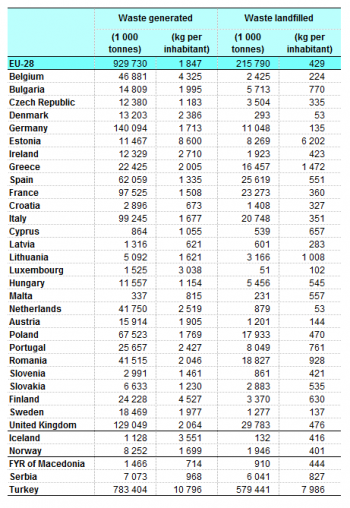Archive:Waste indicators on generation and landfilling - monitoring sustainable development
Waste indicators on generation and landfilling measuring sustainable development 2004-2010
Statistics in focus 22/2013; Author: Karin BLUMENTHAL, Lene BOCHATON
ISSN:2314-9647 Catalogue number:KS-SF-13-022-EN-N
This Statistics Explained article is outdated and has been archived - for recent articles on Environment see here.
This Statistics in focus was prepared in cooperation with Jürgen Gonser from Argus GmbH, Berlin, Germany.
This article analyses in some detail the European Union (EU) sustainable development indicator on waste generation, ‘generation of waste excluding major mineral wastes’ (tsdpc210) and a new landfill indicator ‘landfilling of waste excluding major mineral wastes’, intended to become part of the new set of resource efficiency indicators currently under development.
Since the reference year 2004, Eurostat has collected every two years comprehensive data on waste generation and treatment from EU Member States and EEA/EFTA countries under Regulation 2002/2150/EC on waste statistics. After the fourth round of reporting in June 2012, data are now available for the period 2004 to 2010 and are increasingly used as the basis for indicators in order to monitor waste generation and management in the EU.

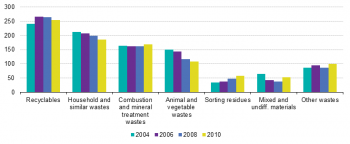
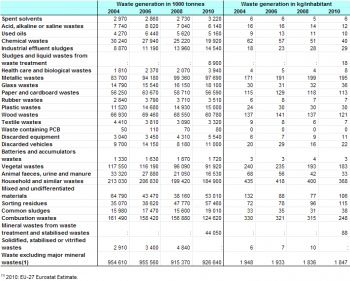
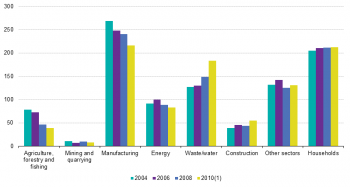
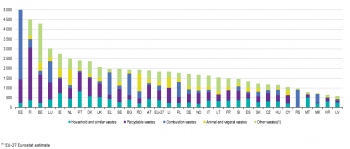


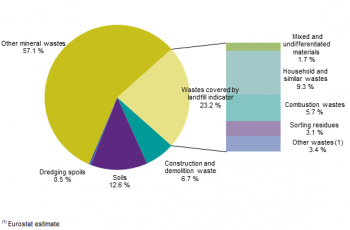

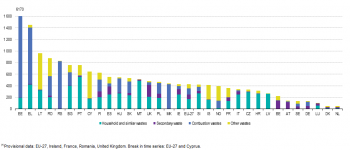
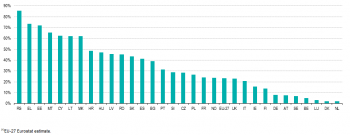
Main statistical findings
Indicator on waste generation excluding major mineral wastes
In 2010, total waste generation in the EU-27 amounted to 2.5 billion tonnes, an average of 4 986 kg per EU inhabitant. 927 million tonnes of this total are covered by the indicator ‘generation of waste excluding major mineral wastes’, corresponding to 1 847 kg/inhabitant and to 37 % of the generated waste total (see Figure 1). Not covered by the indicator are 759 million tonnes of the EWC-Stat[1] ‘other mineral wastes’ (12.2, 12.3, 12.5), which originate mainly from mining activities, 411 million tonnes of excavated ‘soil’ (12.6), 333 million tonnes of ‘mineral construction and demolition waste’ (12.1) and 72 million tonnes of ‘dredging spoils’ (12.7).
The main constituents of waste covered by the waste generation indicator are the categories ‘recyclables’ (06-07.6), which account for 255 million tonnes, ‘household and similar wastes’ (10.1) with 185 million tonnes, ‘combustion wastes’ (12.4) with 125 million tonnes, ‘mineral wastes from waste treatment’ (12.8, 13), referred to as secondary wastes, with 110 million tonnes, and ‘animal and vegetal wastes’ (09) with 108 million tonnes.
The development of waste generation for the EU-27 in the period from 2004 to 2010 is shown in detail in Table 1. The figures indicate that waste generation excluding major mineral wastes has remained largely stable in this period, ranging between 1 948 kg/inhabitant in 2004 and 1 836 kg/inhabitant in 2008. The slight decrease from 2004 to 2010 that is suggested by the figures is rather the result of methodological modifications than a real decrease in waste generation (see next sections).
While the indicator remained basically stable, changes have occurred at the level of waste categories (see Table 1 and Figure 2). The generation of ‘household and similar wastes’ (10.1), which consist mainly of mixed municipal waste, bulky waste and street–cleaning residues, shows a clear and steady downwards trend since 2004. This development can be observed in most Member States and is assumed to result from the extension of separate waste collection systems for recyclable wastes like packaging waste, waste electronic equipment and other recyclables. The decrease can be observed in the household sector, where most of this waste is generated, as well as in most of the economic sectors.
The decrease in 'household and similar waste' corresponds to the steady and strong increase in ‘sorting residues’ (10.3), which is also seen as a result of the enhanced separate collection of recyclables, related sorting and composting activities and the increasing pre-treatment of waste (e.g. by mechanical-biological treatment).
The amounts of generated ‘recyclables’ (06 – 07.6) reflect the amount of metal, glass, paper, plastic, rubber, wood and textile wastes that are collected separately or that are separated from mixed waste by treatment processes. Although one would expect a continuous growth in recyclables as a result of increased separate collection and sorting in Member States, the figures show no clear trend. A more in-depth analysis of the data shows that developments are different depending on the origin of the waste. While the amount of ‘recyclables’ in the household sector has constantly increased since 2004, a decrease in recyclable waste is observed in manufacturing industries. The latter development results mainly from lower amounts of wood waste, paper waste and metal waste. These decreases are assumed to be a combined effect of real developments and the exclusion of by-products from waste statistics (see also comments to Figure 3).
The strong and steady decrease in ‘animal and vegetal wastes’ (09) since 2004 that is suggested by the data can also be attributed to a large extent to methodological adaptations by the countries in the first years of data collection. Such adaptations concern mainly the exclusion of manure and slurry and vegetal by-products from waste statistics.
The amount of ‘mixed and undifferentiated wastes’ (10.2) decreased significantly up to 2008, which is seen as a result of an improved and more specific classification of generated wastes to waste categories. The increase in 2010 is an impact from the Waste Statistics Regulation (WStatR) revision, which has broadened the definition of ‘mixed and undifferentiated wastes’ leading to higher amounts for this waste category.
Figure 3 shows the development of the indicator-related wastes by economic sectors from 2004 to 2010. The sectors that in 2010 contributed most to the indicator-related total of 927 million tonnes are ‘manufacturing industry’ (NACE C) with 216 million tonnes, ‘households’ (212 million tonnes), and ‘waste and water management’ (NACE E, G46.77) (183 million tonnes).
‘Manufacturing industry’ has shown a constant and strong decrease of 53 million tonnes since 2004. This development is mainly due to decreasing amounts of ‘combustion wastes’ (12.4), ‘wood wastes’ (07.5), ‘animal and vegetal wastes’ (09.1, 09.2) and ‘chemical wastes’ (01.4, 02, 03.1) in this sector. The decrease of ‘combustion wastes’ is observed mainly in the metal industry (NACE C24-25). For ‘wood wastes’ and for ‘animal and vegetal wastes’ the decrease is strongly affected by the exclusion of by-products from waste statistics by some countries. Furthermore, ‘household and similar wastes’ (10.1) has shown a strong and constant downwards trend in this sector.
Waste from ‘households’, on the other hand, is almost stable. The data show a slight increase from 2004 to 2008 and a stagnation in 2010. Although the sector total has not shown significant changes from 2004 to 2010, the composition by waste categories shows that the amounts of separately collected ‘recyclables’ (06 – 07.6) and ‘animal/vegetal wastes’ (09.1, 09.2) have increased while ‘household and similar wastes’ have decreased by 10 million tonnes in this period.
The steep increase in waste generation in the ‘water and waste management’ sector (NACE E, G 46.77) is caused by a strong rise in secondary wastes (‘sorting residues’ (10.3) and ‘mineral wastes from waste treatment’ (12.8, 13)), and by continuously growing amounts of ‘recyclables’ (glass, paper, plastics and wood wastes) and ‘common sludges’ (11) from waste water treatment.
The drop of waste generation in the sector ‘agriculture, forestry and fishing’ (NACE A), by about 39.3 million tonnes from 2004 to 2010, reflects a change in data coverage rather than a real decrease in waste. The main reasons for the decrease are the exclusion from waste statistics of ‘manure and slurry’ (09.3’) that are reused in agriculture, and changes of methodology or data source (e.g. replacement of model-based estimates by other data collection approaches).
Figure 4 shows the waste generation indicator in kg/inhabitant for 2010 for each country, broken down into main waste categories. The indicator values for 2010 range between 588 kg/inhabitant in Latvia and 8 556 kg/inhabitant in Estonia. The differences in the amounts and waste categories generated reflect structural differences between the countries.
The high amount of waste in Estonia is mainly due to large quantities of ‘combustion waste’ (12.4) from the energy sector (4 776 kg/inhabitant) and chemical wastes (01.4, 02, 03.1) from the refinery sector (1 064 kg/inhabitant). Both waste types originate from the refinery and incineration of oil shale, which is the main energy source in Estonia. The strong impact on waste generation of the energy sources used is also visible in other countries where energy consumption relies to a high degree on solid fuels (coal, lignite, peat). This is most prominent in Greece, Bulgaria, Poland, Serbia and the FYR of Macedonia, which all have a particularly high consumption of coal and lignite compared to other Member States. In Luxembourg, the high share of combustion waste originates from the strong metal industry.
In Finland, it is ‘wood waste’ (07.5) originating from wood processing, the manufacture of pulp and paper and forestry that leads to a waste generation clearly above the EU average and is reflected by the high share of the waste category recyclables compared to other countries. Belgium reports high amounts of secondary wastes (03.3, 10.3, 12.8, 13), metal wastes (06) and common sludges (11) compared to other countries, which result in the third highest indicator value of all countries.
Considerable amounts of ‘animal and vegetal wastes’ (09) are reported by Romania, the Netherlands and Ireland. In the Netherlands, nearly half of the ‘animal and vegetal wastes’ originate from the food industry while in Ireland the amounts of animal and vegetal wastes are highest in the service sector. In Romania, nearly all ‘animal and vegetal wastes’ come from agriculture and forestry; the high amounts were determined by a model-based estimation and are most likely overestimated.
‘Household and similar waste’ generation amounts to 368 kg/inhabitant in the EU-27 and varies between 202 kg/inhabitant in Norway and 824 kg/inhabitant in Portugal depending on the established waste collection system, national consumption patterns and other factors.
The waste generation indicator covers primary waste as well as waste from waste treatment operations (secondary waste). Secondary waste consists of sorting residues (10.3), mineral wastes from waste treatment (12.8, 13) and sludges and liquid wastes from waste treatment (03.3).
Figure 5 shows that secondary waste accounts for a significant share within the waste generation indicator in countries with a well developed waste management infrastructure. At EU-27 level, the share of secondary waste amounted in 2010 to 12.0 % of the waste generated excl. major mineral wastes. ‘Sorting residues’ accounted for 6.2 %, ‘mineral wastes from waste treatment’ for 4.8 % and ‘liquid wastes and sludges from waste treatment’ for 1.0 % of the generation indicator. Depending on the established waste infrastructure, the share of secondary waste ranges from 0 % in countries with a poor treatment infrastructure to more than 20 % in Belgium and Germany.
Indicator on landfilling of waste excluding major mineral waste
According to the principles of EU waste policies, the disposal of waste should be the last option of waste management. Priority should be given to prevention, reuse, recycling and other forms of recovery. The present state of waste management in the EU in relation to the priorities above is illustrated by Figure 6, which displays the final destination of the 2.34 billion tonnes of waste that were treated in the EU-27 in 2010.
Altogether, 1.2 billion tonnes or 52.8 % of the treated waste were recovered and 1.1 billion tonnes or 47.2 % of wastes were disposed of. Total recovery comprises 244 million tonnes of waste used for backfilling, 90 million tonnes of energy recovery and 901 million tonnes of waste otherwise recycled and recovered. With 926 million tonnes being deposited, landfilling is by far the most important disposal operation. 42 million tonnes are incinerated in dedicated waste incineration facilities and 134 million tonnes of waste are disposed of by other operations like the release of sludges into water bodies or the impoundment of tailings at mine sites.
In Figure 7, the 926 million tonnes of waste that were landfilled are broken down into waste categories; the separate column details the waste categories that are covered by the landfilling indicator. In 2010, the landfill indicator covered 214 million tonnes or 23 % of the landfilled total. Not covered by the indicator are 528 million tonnes of ‘other mineral wastes’ (12.2, 12.3, 12.5), 117 million tonnes of excavated ‘soil’ (12.6), 62 million tonnes of mineral construction and demolition waste (12.1) and 4 million tonnes of dredging spoils (12.7).
The most important waste categories represented by the indicator are ‘household and similar wastes’ (10.1), which account for 86 million tonnes, ‘combustion wastes’ (12.4) with 53 million tonnes, ‘sorting residues’ (10.3) with 28 million tonnes and ‘mixed and undifferentiated wastes’ (10.2) with 16 million tonnes.
Figure 8 shows the landfilling indicator in kg/inhabitant for each country, broken down by main waste category. The detailed data underlying the graph are shown in Table 2.
In 2010, on average 427 kg of waste (excluding major mineral wastes) were landfilled in the EU-27 per inhabitant, of which 172 kg/inhabitant of ‘household and similar waste’ (10.1), 105 kg/inhabitant of ‘combustion wastes’ (12.4), 78 kg/inhabitant of secondary wastes (03.3, 10.3, 12.8, 13) and 72 kg/inhabitant of other wastes.
The landfilled amount per country varied between 53 kg/inhabitant in Denmark and the Netherlands and 6 170 kg/inhabitant in Estonia. The composition of the landfilled amounts shows that the impact of the energy sources used is even stronger for the landfill indicator than for the waste generation indicator. The landfill indicator is dominated by ‘combustion wastes’ (12.4) in Estonia, Greece, Serbia and the FYR of Macedonia, where basically all generated combustion waste was landfilled. ‘Combustion wastes’ also account for a significant share of the landfilled waste in Romania, Bulgaria, Finland, Hungary, Slovakia and Poland.
The amount of ‘household and similar wastes’ (10.1) reflects the stage of the waste management systems and the countries’ policies towards the diversion of waste from landfills. Low amounts of landfilled ‘household and similar wastes’ are reported from countries which have established strict rules such as landfill bans for untreated or combustible waste. This is best illustrated by Germany, Sweden, Austria, Belgium, Denmark and the Netherlands which all reported amounts of ‘household and similar wastes’ landfilled of less than 15 kg/inhabitant for 2010.
Table 3 and Figure 9 combine the two indicators on generation and landfilling and show the landfill rate, i.e. the ratio between the landfilled waste and the generated waste, for each country. The landfill rate expresses how much of the generated waste ends up on landfills and is thus a good indicator of progress or failure with regard to the diversion of waste from landfills.
At the level of the EU-27, 23 % of the generated wastes (excl. major mineral wastes) were finally disposed of at landfills. In seven countries, less than 8 % of the generated wastes were landfilled in 2010. At the other end of the scale, there are seven countries which landfilled more than 60 % of the waste generated.
Data sources and availability
Data on waste generation and treatment are available for four reference years: 2004, 2006, 2008 and 2010. Within the framework of the Waste Statistics Regulation (2002/2150/EC) data are collected according to the Statistical Waste Nomenclature EWC-Stat (Version 4) which is defined in Annex III of the Regulation. A list of all waste categories that have to be reported pursuant to the WStatR is given in Table 4. The list includes the descriptions / labels of the waste categories, the EWC-Stat codes and the codes under which the data for the categories can be downloaded from Eurobase. Table 4 also lists aggregates of waste categories that are used in the text for which the data can be downloaded from Eurobase.
This article presents in detail the sustainable development indicators on waste generation, 'generation of waste excluding major mineral wastes’ (tsdpc210) and the new indicator ‘landfilling of waste excluding major mineral wastes’, intended to become part of the new set of resource efficiency indicators currently under development. Both indicators are based on the same concept, i.e. they exclude from their coverage some waste flows that dominate the waste arising in terms of quantity and tend to overlay trends in waste generation and management. Thus, both indicators cover all waste types except the following waste categories, further referred to as major mineral wastes:
- mineral construction and demolition waste (EWC-Stat 12.1);
- other mineral wastes (12.2, 12.3, 12.5);
- soils (12.6);
- dredging spoils (12.7).
The exclusion of these wastes reduces the coverage of the sustainable development indicators significantly but enhances their sensitivity and comparability across countries. Both are presented in the unit kg/inhabitant.
Croatian data, EU-28 and EU-27
Since 1 July 2013 Croatia is the 28th Member State of the EU and Statistics Explained articles published after this date should in general be based on the new EU-aggregate EU-28. However, the present article still uses the EU-27 aggregate as a basis for the analysis because the Croatian data for the years 2004 to 2010, which were delivered by Croatia on a voluntary basis, were not yet complete (no data on waste generated by households, 2006 data not yet released due to technical issues). The exclusion of the Croatian data does not affect the validity of the developments and conclusions described in the article.
Context
In order to monitor the implementation of waste policy, in particular compliance with the principles of recovery and safe disposal, reliable statistics on the production and management of waste from businesses and private households are required. In 2002, Regulation 2150/2002 on waste statistics was adopted, creating a framework for harmonised Community statistics on waste. Starting with reference year 2004, the Regulation requires EU Member States to provide data on the generation, recovery and disposal of waste every two years.
Since reference year 2004, Eurostat collects every two years comprehensive data on waste generation and treatment from EU Member States and EEA/EFTA countries under the Regulation of Waste Statistics (2002/2150/EC – WStatR). After the fourth reporting in June 2012, data are available for the period 2004 to 2010 and the WStatR data are increasingly used as basis for indicators in order to monitor waste generation and management in the EU.
Two indicators, the indicator ‘Generation of waste excluding major mineral wastes’ (tsdpc210) and the indicator ‘Generation of hazardous waste, by economic activity’ (tsdpc250) are part of the set of sustainable development indicators (SDI). The new indicator ‘Landfilling of waste excluding major mineral wastes’ is intended to become part of the set of resource efficiency indicators (REI) that is currently under preparation.
The EU’s approach to waste management is based on three principles: waste prevention, recycling and reuse, and improving final disposal and monitoring. Waste prevention can be achieved through cleaner technologies, eco-design, or more eco-efficient production and consumption patterns. Waste prevention and recycling, focused on materials technology, can also reduce the environmental impact of resources that are used through limiting raw materials extraction and transformation during production processes. Where possible, waste that cannot be recycled or reused should be safely incinerated with landfills only used as a last resort. Both these methods need close monitoring because of their potential for causing severe environmental damage.
The EU’s sustainable development strategy and its sixth environment action programme, which identifies waste prevention and management as one of seven thematic strategies – titled, ‘Taking sustainable use of resources forward – A thematic strategy on the prevention and recycling of waste’(COM(2005) 666 final), underline the relationship between the efficient use of resources and waste generation and management. The intention of Community policy in this area is to decouple the use of resources and the generation of waste from economic growth, while ensuring that sustainable consumption does not exceed environmental capacity. In order to review the progress being made with respect to the EU’s waste policy, an evaluation of the thematic strategy was carried out in 2010 (COM(2011) 13 final). This report stated that progress had been achieved on a number of fronts, including legislative changes, higher recycling rates, lower amounts of waste going to landfill, and a reduction in hazardous substances for some waste streams. Nevertheless, the conclusions also highlighted a range of issues where improvements could be made, including: the negative environmental impact caused by an expected increase in waste generation, a failure to grasp various opportunities to reduce greenhouse gas emissions, and a lack of progress in creating jobs within environmental services. There were also calls in the report to define new and more ambitious prevention and recycling targets, and to move towards material-specific targets in order to help achieve the Europe 2020 objective of promoting a resource-efficient economy.
Further Eurostat information
Publications
- Environmental statistics and accounts in Europe, Chapter 3 Waste (2010)
- Energy, transport and environment indicators pocketbook (2012 edition)
- Generation and treatment of waste in Europe 2008 (SiF 44/2011)
- Generation and treatment of municipal waste (SiF 31/2011)
Main tables
- Waste statistics
Database
- Environment, see:
- Waste statistics
- Waste generation and treatment (env_wasgt)
Dedicated section
Methodology / Metadata
- Waste generation and treatment (ESMS metadata file — env_wasgt_esms)
Source data for tables and figures (MS Excel)
Other information
- Environmental Data Centre on Waste
- Regulation 2150/2002 of 25 November 2002 on waste statistics
- Thematic strategy on the prevention and recycling of waste
- Being wise with waste: the EU’s approach to waste management
External links
- European Commission - DG Environment - Waste in the EU
- European Environment Agency - Waste and material resources
See also
- All articles on waste statistics
- Monitoring sustainable development (online publication)
Notes
- ↑ Within the framework of the Waste Statistics Regulation (2002/2150/EC) data are collected according to the Statistical Waste Nomenclature EWC-Stat (Version 4) which is defined in Annex III of the Regulation. The figures in brackets to waste categories in the text give the EWC-Stat code of the respective waste category. A list of all waste categories that have to be reported pursuant to the WStatR is given in Table 4 of this article.
